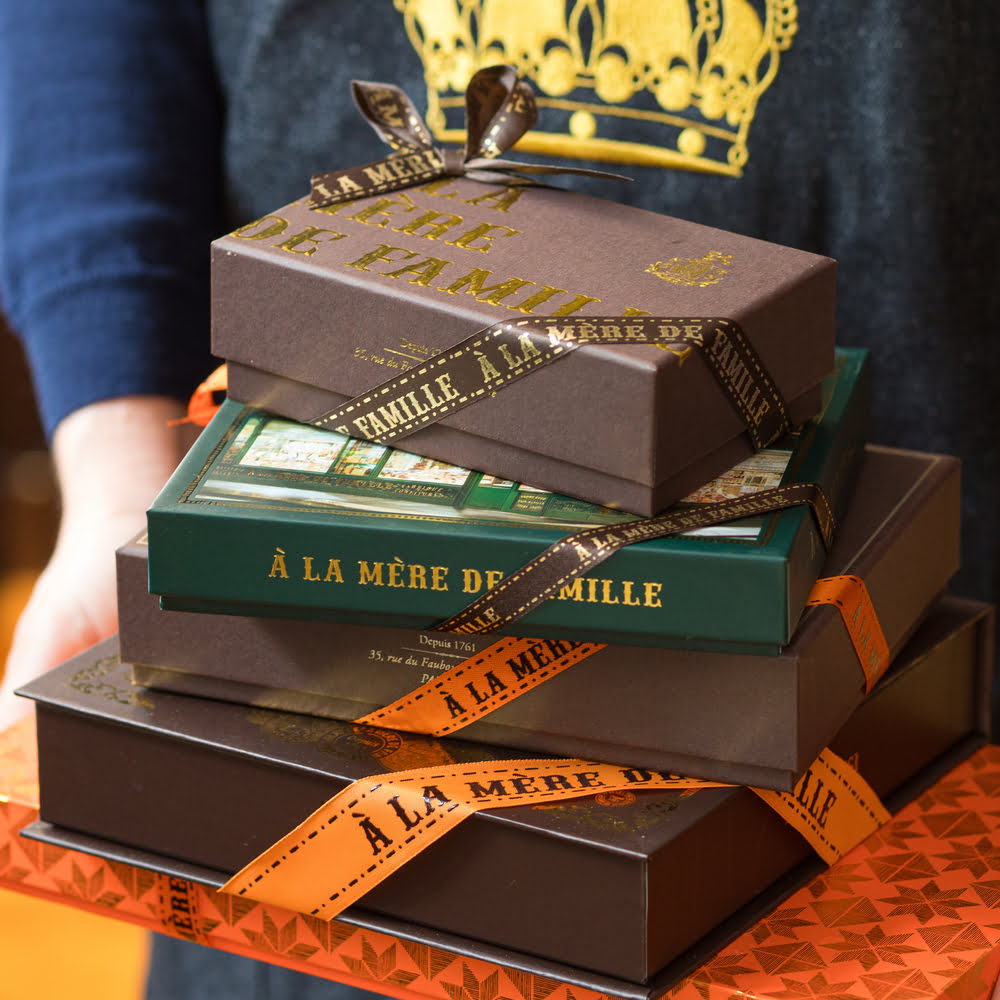Candied Chestnuts
This chestnut, a succulent treat with rare flavors, that we love to share for Christmas and New Year celebrations, or enjoy with a coffee (or tea, no hard feelings). A real little treat renewed every year!
Candied chestnuts
When winter comes, gourmands have an excellent reason to rejoice: the candied chestnut is back at À la Mère de Famille! Because yes, we are not only passionate chocolatiers, we put the same enthusiasm into creating refined and delicious confectionery to delight you.
At À la Mère de Famille, this prestigious and tasty treat is made by hand, using traditional methods, by artisan confectioners who make it especially for us. Did you know that even though they are called "marron glacés", they are chestnuts with delicate aromas and full of roundness, candied in a sugar syrup and covered in icing sugar? The House offers this elegant confectionery in two recipes, to be nibbled just for the pleasure! All you have to do is add it to your holiday wish list!
Golden or coppery chestnut: discover our candied chestnut recipes
At À la Mère de Famille, we offer two recipes for candied chestnuts. Purists will be delighted by tasting our Marron Doré. Soft and melting, it follows all the traditional steps of making candied chestnuts, for elegant and comforting flavors. Because we love challenges, we also came up with our own recipe for Marron Cuivré, inspired by a 19th century method. It took us three years to perfect it! This less candied Signature Marron glacé stands out with its very fine glaze that preserves the authentic flavor of the chestnut. It is firmer in the mouth and less sweet than the Marron Doré. Of course, you will only find it at À la Mère de Famille. In addition to being delicious, our candied chestnuts are beautiful, as is the box that will allow you to take them home safely. Do you want a waltz of flavors? Then opt for a box or a ballotin of candied chestnuts, completed with an assortment of seasonal gourmet products. Do you prefer to savor them one by one? You can of course buy them individually if you wish. prefer.
But what is a candied chestnut?
Why do candied chestnuts taste like chestnuts? Because they are chestnuts candied in sugar syrup and glazed with icing sugar. The horse chestnut, the fruit of the chestnut tree that young people love to pick at the beginning of autumn, is unfit for consumption. The chestnut was renamed marron in the 17th century to appeal to more gourmands. In fact, the fruit of the chestnut tree was at the time mainly consumed by the most modest, which harmed its sex appeal.
Presenting it in the form of candied chestnuts allowed him to win over the most prestigious tables of the time, including that of Louis XIV who was crazy about them, according to legend. And yet, he had not tasted those from À la Mère de Famille, voted the best candied chestnuts in Paris according to the opinion of the Figaroscope!
The fabulous story of the candied chestnut
Like all stars, the story of the candied chestnut has given rise to many versions, with France and Italy arguing over its invention. François Pierre de la Varenne presents his recipe for chestnuts cooked with sugar in his book Le parfait confiturier, in the 17th century, the time of Louis XIV. Others Sources mention a creation at the same time at the court of Savoy, by a cook of Duke Charles Emmanuel I. There is also talk of an appearance in the 15th century, sometimes in Lyon, sometimes in Cuneo, in the North of Italy. The first French candied chestnut factory was created in 1882 in Ardèche, a region rich in chestnuts, before launching a little later the chestnut cream, made from the broken candied chestnuts created during their manufacture. In all cases, the candied chestnut, a prized delicacy, enjoys the same success wherever its incomparable flavors are found.
Our secrets for making candied chestnuts À la Mère de Famille style
If candied chestnuts are a prestigious treat, it is because each stage of their production is artisanal from start to finish, and requires as much know-how as patience.
Harvest
It all starts with the choice of chestnuts and their harvesting method. Ours come from Turin, a region where chestnuts are queen. They are harvested by hand, in the fall, the peak season for chestnuts, in order to preserve all their flavors. This seasonality explains why the House chooses to only offer its candied chestnuts in winter, just like our delicious truffles with chocolate. The chestnuts are selected to keep only the most beautiful chestnuts, of equivalent size: a careful and delicate sorting!
Peeling and swaddling
The chestnuts, still protected by their shell, are peeled with steam. The shell is detached from the chestnut, and the last veins are removed with a knife. The whole naked chestnuts are then wrapped by hand in small squares of white tulle.
Cooking and covering with icing sugar
At À la Mère de Famille, the swaddled chestnuts are first cooked in a bath of gently boiling water, then candied for nearly two days in sugar syrup, so that it penetrates to the heart of the fruit. They then rest for several days to perfect their candiedness. They are just a few steps away from becoming candied chestnuts! The tulle is removed by hand, then the chestnuts are covered with a very thin layer of sugar to preserve their aromas. They are baked one last time in the oven to crystallize the icing, before being lovingly packaged by our artisans in an individual envelope. Here are our candied chestnuts ready to be enjoyed!
What are the differences between our classic Candied Chestnuts and our signature Candied Chestnuts?
Classic Golden Candied Chestnuts
Our classic candied chestnuts, recognizable by their golden packaging, are made with chestnuts of the so-called "Turin" shape. Our artisans candied them in a sugar syrup with Bourbon vanilla from Madagascar, before covering them with a thin film of icing sugar. Our Chestnuts Golden glazed cookies are as soft as they melt in the mouth.
Signature Bronzes Candied Chestnuts
For this recipe developed by the House, our carefully selected chestnuts are also candied in a light vanilla sugar syrup. The difference is in the rendering: less sweet, the Signature chestnut is also firmer. You will recognize them by their paper with slightly darker reflections.
Can candied chestnuts be frozen?
Do you love candied chestnuts so much that you're thinking about storing them by freezing them? We understand! The ones you find in our À la Mère de Famille stores are of course not frozen: they arrive fresh and ready to go to you! However, this fragile product dries out little by little, and then loses its flavors. You can therefore freeze them if you wish, in order to then use the candied chestnuts as a break in a Mont-Blanc recipe, for example.
How to store your candied chestnuts?
Are you planning to enjoy your candied chestnuts soon? For optimal conservation, we advise you to keep them in the vegetable drawer of your refrigerator, at a temperature between +4 and +8 °C. Take them out an hour before biting into them: each candied chestnut will thus regain all its softness. We also suggest that you do not wait too long to taste them. That's good, you can't wait to taste them!
Tell me, why do we say candied chestnut?
Contrary to what we sometimes imagine, candied chestnuts are not ice creams. As you will have understood, this treat takes its name from its sugar glaze, with crystalline and shiny reflections, which gives it part of its prestige. At À la Mère de Famille, we are committed to ensuring that this veil sugar remains very light in order to preserve all the flavors of the chestnut. Fancy another treat? Have you tried our orangettes yet?
How to satisfy your craving for candied chestnuts?
Do you have a sudden craving for candied chestnuts, or do you want to spoil a loved one by sending them this sweet treat? Simply visit the store and choose the chestnut box of your choice. You can also order an assortment on our site, and pick it up in store at the time of your choice, or have it delivered wherever you want in France and Europe. We explain our delivery options to you















